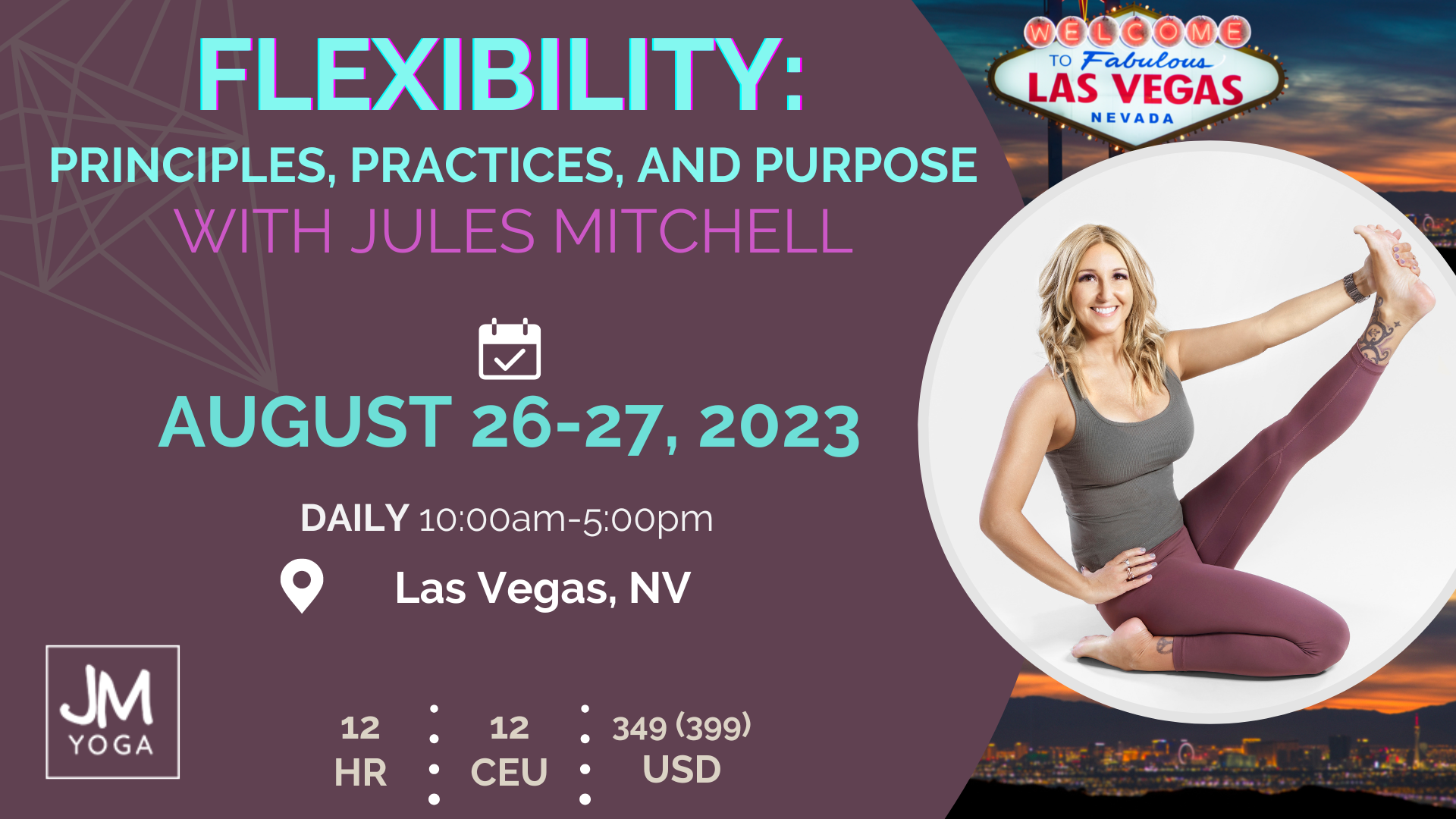Flexibility Course | Las Vegas
A unique and all-new course where you’ll explore a variety of stretching techniques and learn to determine which methods are best for certain outcomes. Jules has spent the last decade teaching yoga teachers about the science, biomechanics, and physiology of stretching and is excited to bring these elements into a practical and usable course.

Flexibility:
Principles, Practices, and Purpose
10 hours of education, application, and in-person interaction with Jules.
August 26-27, 2023
Saturday-Sunday
10:00am – 5:00pm local time
$349 USD until Aug. 1st
$399 USD after
Seven Hills Conference Center
3215 St Rose Pkwy
Henderson, NV 89052
How much does flexibility
matter and when?
What the science says
about ROM and injury.
Why some stretching
methods don’t work.
How To Know If This Las Vegas Flexibility Course Is For You:
- Have you been told passive stretching is dumb?
- Are you being sold mobility hacks all over social media?
- Do you want to understand the pros and cons of end-range poses?
- Have you been told hypermobile people shouldn’t stretch?
- Do you want to prevent the common hamstring tendinopathies we see in yoga?
- Are you confused about whether to bend or straighten your knees in hamstring stretches?
- Are you unsure of how to explain the effects of yin yoga on connective tissue?
- Do you want clarity on stretch tolerance and other mediators of flexibility?
- Are you clear and confident (or confused and uncertain) in the definition of overstretching?
- Are you curious about what the research actually says about stretching?
- Do you want to know how to build different stretching techniques into your sequences?
If you answered yes to any of these questions you will love the information I provide in this course.
This is my newest course and I’m loving how it’s unfolding. We spend 2 full days stretching our bodies and our brains. I encourage questions, curiosity, and conversation.
Unpack the complexities
of eccentric contractions.
Master the various
muscle contraction types.
How to “stretch” without
really stretching.
Course Objectives
This Las Vegas flexiblity course is for teachers who either love or hate stretching (and everyone else who doesn’t know what to think about it anymore). Jules shares what the research says about stretching while encouraging you to challenge your beliefs in an enthusiastic and non-dogmatic manner. Be ready for a fun and positive experience!
Disassociate mechanical tension
from “stretching”.
Learn self stretches
and partner stretches.
Reinvigorate yoga sequences
with stretching.
This course will teach you to:
- Distinguish between the 6 different stretching modalities.
- Incorporate a variety of stretching techniques into yoga sequences.
- Learn how to increase range of motion safely and effectively.
- Understand eccentric contractions and the latest research
- Master muscle physiology and how load fits into the stretching narrative.
- Explore connective tissue mechanics in multiple contexts such as pain, injury, and ROM.
- Question the physical, mental, and emotional benefits of stretching practices.
- Recognize common stretching myths and misconceptions.
- Troubleshoot and select modifications to best attain desired results.
- Gain the knowledge and skills necessary to confidently talk about how stretching works.
Jules has spent the last decade teaching yoga teachers about the science, biomechanics, and physiology of stretching. She is a regular contributor to yoga teacher training programs worldwide, providing yoga schools with the most current research in biomechanics. You can learn more about her book Yoga Biomechanics, Stretching Redefined here.
Course Description
If you are a stretching enthusiast, a stretching skeptic, or anywhere in between, this course is for you! Join Jules Mitchell for a 2-day intensive that weaves together a variety of stretching techniques with asana to immediately impact your cueing, adjustments, and sequencing. Empowered with the latest research in stretching and flexibility, plus practical uses for the various stretching techniques, you’ll gain confidence and inspiration in your teaching for years to come.
Course Topics
- Static stretching and why it’s so controversial yet widely popular.
- Trends in ballistic stretching and plyometrics.
- Isometric stretching versus end-range focused stretching.
- Viscoelastic properties of titin and collagen.
- Eccentric overload versus negative eccentrics.
- Resistance stretching and central nervous system adaptations.
- Mechanisms of stretching and strength.
- Dynamic stretching and its applications.
Handouts/slides included.
Eligible for 10 CEUs.
Questions encouraged!
